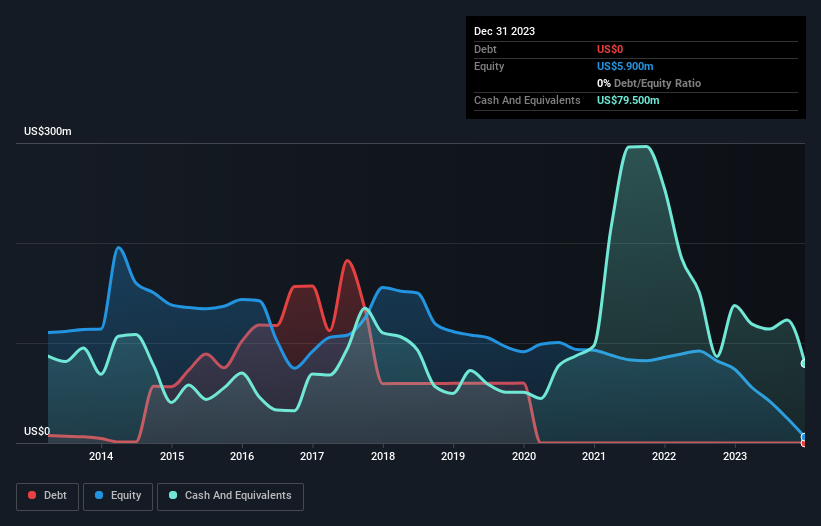We Think Philly Shipyard (OB:PHLY) Needs To Drive Business Growth Carefully

There's no doubt that money can be made by owning shares of unprofitable businesses. For example, although software-as-a-service business Salesforce.com lost money for years while it grew recurring revenue, if you held shares since 2005, you'd have done very well indeed. But while history lauds those rare successes, those that fail are often forgotten; who remembers Pets.com?
So should Philly Shipyard (OB:PHLY) shareholders be worried about its cash burn? In this article, we define cash burn as its annual (negative) free cash flow, which is the amount of money a company spends each year to fund its growth. First, we'll determine its cash runway by comparing its cash burn with its cash reserves.
View our latest analysis for Philly Shipyard
When Might Philly Shipyard Run Out Of Money?
You can calculate a company's cash runway by dividing the amount of cash it has by the rate at which it is spending that cash. In December 2023, Philly Shipyard had US$80m in cash, and was debt-free. Importantly, its cash burn was US$59m over the trailing twelve months. So it had a cash runway of approximately 16 months from December 2023. While that cash runway isn't too concerning, sensible holders would be peering into the distance, and considering what happens if the company runs out of cash. You can see how its cash balance has changed over time in the image below.

How Well Is Philly Shipyard Growing?
We reckon the fact that Philly Shipyard managed to shrink its cash burn by 50% over the last year is rather encouraging. Revenue also improved during the period, increasing by 13%. It seems to be growing nicely. In reality, this article only makes a short study of the company's growth data. You can take a look at how Philly Shipyard has developed its business over time by checking this visualization of its revenue and earnings history.
How Easily Can Philly Shipyard Raise Cash?
Philly Shipyard seems to be in a fairly good position, in terms of cash burn, but we still think it's worthwhile considering how easily it could raise more money if it wanted to. Generally speaking, a listed business can raise new cash through issuing shares or taking on debt. One of the main advantages held by publicly listed companies is that they can sell shares to investors to raise cash and fund growth. By looking at a company's cash burn relative to its market capitalisation, we gain insight on how much shareholders would be diluted if the company needed to raise enough cash to cover another year's cash burn.
Since it has a market capitalisation of US$45m, Philly Shipyard's US$59m in cash burn equates to about 132% of its market value. Given just how high that expenditure is, relative to the company's market value, we think there's an elevated risk of funding distress, and we would be very nervous about holding the stock.
Is Philly Shipyard's Cash Burn A Worry?
Even though its cash burn relative to its market cap makes us a little nervous, we are compelled to mention that we thought Philly Shipyard's cash burn reduction was relatively promising. Summing up, we think the Philly Shipyard's cash burn is a risk, based on the factors we mentioned in this article. On another note, Philly Shipyard has 3 warning signs (and 1 which doesn't sit too well with us) we think you should know about.
Of course Philly Shipyard may not be the best stock to buy. So you may wish to see this free collection of companies boasting high return on equity, or this list of stocks that insiders are buying.
New: Manage All Your Stock Portfolios in One Place
We've created the ultimate portfolio companion for stock investors, and it's free.
• Connect an unlimited number of Portfolios and see your total in one currency
• Be alerted to new Warning Signs or Risks via email or mobile
• Track the Fair Value of your stocks
Have feedback on this article? Concerned about the content? Get in touch with us directly. Alternatively, email editorial-team (at) simplywallst.com.
This article by Simply Wall St is general in nature. We provide commentary based on historical data and analyst forecasts only using an unbiased methodology and our articles are not intended to be financial advice. It does not constitute a recommendation to buy or sell any stock, and does not take account of your objectives, or your financial situation. We aim to bring you long-term focused analysis driven by fundamental data. Note that our analysis may not factor in the latest price-sensitive company announcements or qualitative material. Simply Wall St has no position in any stocks mentioned.
About OB:PHLY
Philly Shipyard
Operates a commercial shipyard that builds and repairs vessels for the United States Jones Act market and government.
Slight and slightly overvalued.


